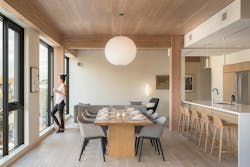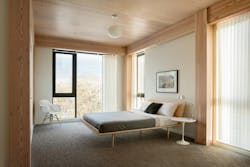Can mass timber and prefab housing construction be stronger together? Yes, they can, according to Todd Beyreuther, director of product at Mercer Mass Timber (MMT).
At its factories in Arkansas, British Columbia, and Washington, MMT—a subsidiary of Mercer International, a global producer of pulp and wood products—traditionally has produced cross-laminated timber (CLT) and glued-laminated timber (GLT) for beams and columns used in large commercial buildings.
While the commercial mass timber market continues to grow, MMT also increasingly is supplying mass timber for both detached and attached housing projects—including prefab panelized and volumetric modular construction.
“That’s where the mass timber industry is going,” Beyreuther says of MMT’s interest in housing. “It’s an important market that’s in need, but it’s also moving more and more toward prefabrication. Mass timber is inherently prefab, so it’s a natural progression.”
MMT is following that natural progression by creating mass timber products for prefab factories.
Mass Timber Meets Prefabrication
“For us to contribute to the housing crisis, we need to think about how we offer components and assemblies that are relevant for multiple secondary manufacturers, especially in the prefab world,” Beyreuther says.
Mass timber’s benefits, according to Beyreuther, include its speed and quality. The quality involves wood’s aesthetic and biophilic effects, in addition to mass timber’s proven fire performance. And because it’s produced in the factory at the same time site work gets done, mass timber can speed up the overall construction timeline.
But mass timber also can be more expensive than traditional building materials. “It’s obviously more material, so no one should state that mass timber is directly competitive—material cost to material cost—with stick frame buildings. That’s not the proposition,” Beyreuther says. “The proposition is finding scale and speed in the factory and demonstrating overall cost savings on the project.”
MMT’s proposition, Beyreuther explains, is that long-term savings can be realized particularly on for-rent or for-lease developments. That’s because of the operational performance of mass timber, with its greater air tightness and thermal performance. So, while mass timber itself is more costly than traditional materials, its energy efficiency leads to savings in the long run.
“You have to make it competitive from a cost standpoint when you add more material,” Beyreuther says. “You have to demonstrate why you’d do this from a labor and materials standpoint.”
In terms of material, mass timber, Beyreuther says, reduces the use of other materials, such as sheetrock. And in terms of labor, mass timber reduces the need for costly, in-demand onsite labor, as it requires people trained to run machines rather than hard-to-find, traditional tradespeople.
RELATED
- Combining Mass Timber with Modularity
- New York’s Largest and Tallest Mass Timber Building
- A 'New Generation' of Building Materials
“With modular, we use the technology available to us in our factories to produce a product that’s very efficient and competitive. And we offer that to architects, engineers, and developers so they have repeatable designs in our factory—and they can hit print any time they’re ready,” Beyreuther says. “That’s what really drives down the cost, makes mass timber competitive, and gets us a higher-quality, predictable product.”
Beyreuther, who’s active in both development and building code planning, notes that the West Coast states have been leading the way in the adoption of codes that enable more extensive and more flexible uses of mass timber. “The three Western states [of California, Oregon, and Washington] are helping to lead the country,” he says.
Recent building code changes now allow taller mass timber buildings, and more cities are now embracing the product. Beyreuther points to Milwaukee, where the 25-story Ascent tower is the world’s tallest hybrid mass timber structure—and will soon be surpassed by Milwaukee’s 32-story apartment building The Edison.

